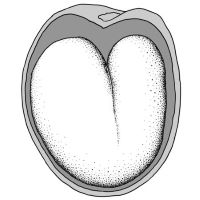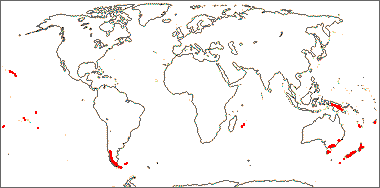Family name: Asteliaceae Dumort.
Synonym(s): [none]
Common name(s): silver spear family
*Number of genera/species: 3/37
List of genera records in GRIN-Global
fruit or seed
Fruit usually a berry or apically dehiscentdehiscent:
(v. dehisce) splitting open at maturity to release contents (of a fruit) capsule (Milligania), 2–18 mm long, globoseglobose:
capsule (Milligania), 2–18 mm long, globoseglobose:
3D shape—more or less spherical , ovoidovoid:
, ovoidovoid:
3D shape—ovate , oblongoblong:
, oblongoblong:
2D shape—much longer than broad with nearly parallel sides, corners are rounded , flask-shapedflask-shaped:
, flask-shapedflask-shaped:
3D shape—generally circular in cross-section, broadest at or below the middle, approximately globose below that and constricted above to a relatively narrow neck
, sometimes sulcatesulcate:
surface relief—having one or more elongate, relatively narrow and shallow depressions or grooves , tereteterete:
, tereteterete:
approximately circular in cross section; width and thickness approximately equal
 or triangulartriangular:
or triangulartriangular:
2D shape—three relatively straight sides with distinct corners; more angular than teardrop-shaped in transection, persistent perianthperianth:
in transection, persistent perianthperianth:
collective term for calyx and corolla of a flower
 , with few to many seeds. Pericarppericarp:
, with few to many seeds. Pericarppericarp:
fruit wall or fruit coat
orange, red, or green, fleshy.
Seeds ovoidovoid:
3D shape—ovate to angularangular:
to angularangular:
2D shape—having sides that meet at acute or obtuse angles
, 1–2.5 mm long, hila larger than punctatepunctate:
surface relief—dotted with pits or with translucent, sunken glands or with colored dots, similar to pitted . Seed coat black, shinyshiny:
. Seed coat black, shinyshiny:
uniformly reflecting a high proportion of incident light at all angles , hard, crustaceouscrustaceous:
, hard, crustaceouscrustaceous:
texture—thin, dry, indurate, and brittle
layer of black phytomelanphytomelan:
carbonaceous, opaque material that usually covers the seed coat to give it a black appearance, common in certain monocot families , smooth or sculptured. Seeds embedded in funicularfuniculus:
, smooth or sculptured. Seeds embedded in funicularfuniculus:
(alt. funicle) stalk connecting the ovule (later seed) to the ovary (later fruit) placenta mucilaginous hairs in Collospermum.
mucilaginous hairs in Collospermum.
Embryo well developed, linearlinear:
(shape) long, narrow, and uniform in width; (of embryo) embryo is straight and much longer than wide , straight or bentbent:
, straight or bentbent:
(of embryo) embryo is bent at an acute, V-shaped angle with the ends close together and generally thick cotyledons .
.
Endosperm copious.
| Fruit | |
| Type | berryberry: an indehiscent, fleshy fruit with one or a few to many seeds. The flesh may be homogenous throughout. Or, if the outer part is hard, firm, or leathery, referred to as an hesperidium. Septa are present in some, and the seeds may be arillate or with a fleshy testa.  , capsulecapsule: , capsulecapsule:a dry, dehiscent fruit derived from a compound ovary  |
| Size range | 2–18 mm long |
| Shape(s) | globoseglobose: 3D shape—more or less spherical  , ovoidovoid: , ovoidovoid:3D shape—ovate  , oblongoblong: , oblongoblong:2D shape—much longer than broad with nearly parallel sides, corners are rounded  , flask-shapedflask-shaped: , flask-shapedflask-shaped:3D shape—generally circular in cross-section, broadest at or below the middle, approximately globose below that and constricted above to a relatively narrow neck |
| Texture | fleshy |
| Surface relief | sometimes sulcatesulcate: surface relief—having one or more elongate, relatively narrow and shallow depressions or grooves  |
| Color(s) | orange, red, green |
| Unique features | Brightly colored berriesberry: an indehiscent, fleshy fruit with one or a few to many seeds. The flesh may be homogenous throughout. Or, if the outer part is hard, firm, or leathery, referred to as an hesperidium. Septa are present in some, and the seeds may be arillate or with a fleshy testa.  with persistent perianthperianth: with persistent perianthperianth:collective term for calyx and corolla of a flower  and black, shinyshiny: and black, shinyshiny:uniformly reflecting a high proportion of incident light at all angles  , phytomelan-encrusted seeds. , phytomelan-encrusted seeds. |
| Seed | |
| Size range | 1–2.5 mm long |
| Shape(s) | ovoidovoid: 3D shape—ovate  , ellipsoidellipsoid: , ellipsoidellipsoid:3D shape—elliptic , fusiformfusiform: spindle-shaped; broadest at the middle and tapering at both ends  , polygonalpolygonal: , polygonalpolygonal:angular |
| Surface relief | smooth or sculptured; with phytomelanphytomelan: carbonaceous, opaque material that usually covers the seed coat to give it a black appearance, common in certain monocot families  crust crust |
| Color(s) | black |
| Unique features | Seeds with funicularfuniculus: (alt. funicle) stalk connecting the ovule (later seed) to the ovary (later fruit) placenta  mucilaginous hairs in Collospermum and glabrousglabrous: mucilaginous hairs in Collospermum and glabrousglabrous:without hairs in other genera. |
| Other | |
| Embryo | well developed, linearlinear: (shape) long, narrow, and uniform in width; (of embryo) embryo is straight and much longer than wide  , straight or bentbent: , straight or bentbent:(of embryo) embryo is bent at an acute, V-shaped angle with the ends close together and generally thick cotyledons  , one third to one half the length of the seed , one third to one half the length of the seed |
| Nutritive tissue | endosperm copious |
Australia, Pacific Islands, New Guinea, the Mascarenes, and South America (Chile).

Distribution map courtesy of Angiosperm Phylogeny Website.
Baskin and Baskin 2021Baskin and Baskin 2021:
Baskin C and Baskin J. 2021. Relationship of the lateral embryo (in grasses) to other monocot embryos: A status up-grade. Seed Science Research 31 (3): 199-210. doi:10.1017/S0960258521000209; Birch 2015Birch 2015:
Birch JL. 2015. A revision of infrageneric classification in Astelia Banks amp; Sol. ex R.Br. (Asteliaceae). PhytoKeys 52 (1): 105-132. https://doi.org/10.3897/phytokeys.52.4768; Dahlgren et al. 1985Dahlgren et al. 1985:
Dahlgren RMT, Clifford HT, and Yeo PF. 1985. The families of the monocotyledons: structure, evolution, and taxonomy. Springer-Verlag, Berlin. 520 pp.; Flora of Australia 2021+Flora of Australia 2021+:
Flora of Australia. Australian Biological Resources Study, Canberra. Accessed January 2021–March 2024. URL: http://www.ausflora.org.au; Kirkbride et al. 2006Kirkbride et al. 2006:
Kirkbride JH, Jr, Gunn CR, and Dallwitz MJ. 2006. Family guide for fruits and seeds, vers. 1.0. Accessed September 2020-January 2022. URL: https://nt.ars-grin.gov/seedsfruits/keys/frsdfam/index.cfm .; Kubitzki et al. 1990+Kubitzki et al. 1990+:
Kubitzki K et al., eds. 1990+. The families and genera of vascular plants. 7+ vols. Berlin etc.; Stevens 2001+Stevens 2001+:
Stevens PF. 2001+. Angiosperm Phylogeny Website Version 14, July 2017 [and more or less continuously updated since]. Accessed September 2020-2022. URL: http://www.mobot.org/MOBOT/research/APweb/; Stevenson and Loconte 1995Stevenson and Loconte 1995:
Stevenson DW and Loconte H. 1995. A cladistic analysis of monocot families. In: Rudall PJ, Cribb PJ, Cutler DF, and Humphries CJ, eds. Monocotyledons: Systematics and Evolution. Royal Botanic Gardens, Kew.; Takhtajan 2009Takhtajan 2009:
Takhtajan A. 2009. Flowering plants: Second edition. Springer Nature, Switzerland. 871 pp.; Watson and Dallwitz 1992+Watson and Dallwitz 1992+:
Watson L and Dallwitz MJ. 1992+. The families of flowering plants: descriptions, illustrations, identification, and information retrieval. Version: 6th Accessed September 2020-September 2022. URL: delta-intkey.com
*The number of genera and species is based on Christenhusz and Byng 2016Christenhusz and Byng 2016:
Christenhusz MJM and Byng JW. 2016. The number of known plant species in the world and its annual increase. Phytotaxa 261 (3): 201-217. https://doi.org/10.11646/phytotaxa.261.3.1, which may differ from the number of genera in GRIN-Global.